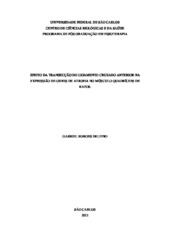Efeito da transecção do ligamento cruzado anterior na expressão de genes de atrofia no músculo quadríceps de ratos
Resumo
The quadriceps muscle weakness and atrophy after the anterior cruciate ligament (ACL) rupture, is present before and after its reconstruction, and are important limitations that restrict the return of subjects to activities of daily living and sports. The combination of reduced synthesis and increased levels of protein degradation results in a rapid loss of muscle protein. The rapid muscle proteolysis occurs in several animal models and in different conditions in humans, and are mainly associated to the ubiquitn proteasome system (UPS). Neuromuscular mechanisms are associated with atrophy and weakness of the quadriceps muscle after ACL rupture and reconstruction, but the molecular pathways involved in this process are unknown. The identification of these pathways may facilitate the establishment of therapeutic strategies to alleviate the muscle deficit. Thus, the objective of this thesis was to evaluate the effect of ACL transection of rats in the expression of genes of UPS (MuRF-1, Atrogina-1), as well as the expression of myostatin (involved in control of muscle mass) by the Real Time PCR (polymerase chain reaction) technique. It was evaluated the content of ubiquitinated proteins by Western blotting and the cross-sectional area of muscle fibers (CSA) of the vastus medialis (VM), rectus femoris (RF) and vastus lateralis (VL) of the quadriceps. Elevated Atrogin-1, MuRF-1 and myostatin mRNA levels were observed after ACL transection in all muscles assessed, as the reduction of CSA in VM and VL muscles. The results of this thesis contributed to the understanding of the mechanisms of quadriceps muscle atrophy after ACL transection.
